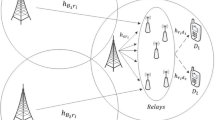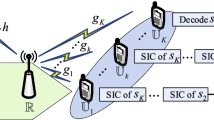Abstract
In this paper, the relationship between the energy efficiency in terms of the total consumed power per bit and the spectral efficiency is studied for dual-hop cooperative relaying systems consisting of multiple single-antenna amplify-and-forward relays. Considering the source and relay transmit antenna gains, the path-loss fading and the power consumption model as a whole, a new metric to measure the energy to spectral-efficiency trade-off (ESET) is formulated. Based on the convexity analysis of the new cost function, an analytical expression of the minimum per-bit power consumed by the whole relay system is derived as a general framework of the best ESET for given number of relays and relay-to-source power allocation. The relay-to-source power ratio is then further optimized, leading to a closed-form solution to relay design and power allocation. Numerical simulation results validating the theoretical analysis and the derived optimal ESET are provided.








Similar content being viewed by others
References
Wang, J., Zhu, H., & Gomes, N. J. (2012). Distributed antenna systems for mobile communications in high speed trains. IEEE Journal on Selected Areas in Communications, 30(4), 675–683.
Sun, F., de Carvalho, E., Popovski, P., & Thai, C. (2012). Coordinated direct and relay transmission with linear non-regenerative relay beamforming. IEEE Signal Processing Letters, 19(10), 680–683.
Liu, H., Sun, F., de Carvalho, E., Popovski, P., Thomsen, H., & Zhao, Y. (2013). MIMO four-way relaying. In IEEE 14th International Workshop on Signal Process. Advances for Wireless Comm. (SPAWC) (pp. 1–5).
Seoul National University. (2011). Program guide of GreenTouch Open Forum. Seoul: Seoul National University.
Zeller, D., Olsson, M., et al. (July 2012) EARTH: deriving the energy efficiency of wireless infrastructure to its limits, FP7 ICT Objective 1.1 the network of the future, Project Description, Contract No. INFSO-ICT-247733
Chen, Y. (2011). GREAT project overview (pp. 1–22). Seoul: GreenTouch Open Forum.
Laneman, J. N., & Wornell, G. W. (2000). Energy-efficient antenna sharing and relaying wireless networks. In Proceedings of IEEE WCNC, 3 (pp. 7–12).
Verdu, S. (2002). Spectral efficiency in the wideband regime. IEEE Transactions on Information Theory, 48(6), 1319–1343.
Cui, S., Goldsmith, A., & Bahai, A. (2004). Energy-efficiency of MIMO and cooperative MIMO techniques in sensor networks. IEEE Journal on Selected Areas in Communications, 22(6), 1089–1098.
Zhou, Z., Zhou, S., Cui, J.-H., & Cui, S. (2008). Energy-efficient cooperative communication based on power control and selective single-relay in wireless sensor networks. IEEE Transactions on Wireless Communications, 7(8), 3066–3078.
Eickhoff, R., Kraemer, R., Santamaris, I., & Gonzalez, L. (2009). Developing energy-efficient MIMO radios. IEEE Vehicular Technology Magazine, 4(1), 34–41.
Dechene, D. J., & Shami, A. (2010). Energy efficient quality of service traffic scheduler for MIMO downlink SVD channels. IEEE Transactions on Wireless Communications, 9(12), 3750–3761.
Miao, G., & Zhang, J. (2011) On optimal energy-efficient multi-user MIMO. In Proceeding of IEEE Globecom (pp. 1–6).
Jain, A., Kulkarni, S. R., & Verdu, S. (2011). Energy efficiency of decode-and-forward for wideband wireless multicasting. IEEE Transactions on Information Theory, 57(12), 7695–7713.
Zhang, W., Duan, D., & Yang, L. (2011). Relay selection from a battery energy efficiency perspective. IEEE Transactions on Communications, 59(6), 1525–1529.
Prabhu, R. S., & Daneshrad, B. (2012). Performance analysis of energy-efficient power allocation for MIMO-MRC systems. IEEE Transactions on Communications, 60(8), 2048–2053.
Abuzainab, N., & Ephremides, A. (2012). Energy efficiency of cooperative relaying over a wireless link. IEEE Transactions on Wireless Communications, 11(6), 2076–2083.
He, C., Sheng, B., Zhu, P., & You, X. (2012). Energy efficiency and spectral efficiency tradeoff in downlink distributed antenna systems. IEEE Wireless Communication Letters, 1(3), 153–156.
Zhang, J., Yang, L.-L., & Hanzo, L. (2013). Energy-efficient dynamic resource allocation for opportunistic-relaying-assisted SC-FDMA using turbo-equalizer-aided soft decode-and-forward. IEEE Transcactions on Vehicular Technology, 62(1), 235–246.
Chen, Y., Zhang, S., Xu, S., & Li, G. Y. (2011). Fundamental trade-offs on green wireless networks. IEEE Communication Magazine, 49(6), 30–37.
Heliot, F., Imran, M. A., & Tafazolli, R. (2012). On the energy efficiency-spectral efficiency trade-off over the MIMO Rayleigh fading channel. IEEE Transactions on Communications, 60(5), 1345–1356.
Onireti, O., Heliot, F., & Imtran, M. A. (2012). On the energy-spectral efficiency trade-off in the uplink of CoMP system. IEEE Transactions on Wireless Communications, 11(2), 556–561.
Bae, C., & Stark, W. E. (2009). End-to-end energy-bandwidth tradeoff in multihop wireless networks. IEEE Transactions on Information Theory, 55(9), 4051–4066.
Chen, C.-L., Stark, W. E., & Chen, S.-G. (2011). Energy-bandwidth efficiency tradeoff in MIMO multi-hop wireless networks. IEEE Journal on Selected Areas in Communications, 29(8), 1537–1546.
Fan, Y., Wang, C., Poor, H. V., & Thompson, J. S. (2009). Cooperative multiplexing: Toward higher spectral efficiency in multiple-antenna relay networks. IEEE Transactions on Information Theory, 55(9), 3909–3926.
Sun, F., Kim, T. M., Paulraj, A. J., de Carvalho, E., & Popovski, P. (2013). Cell-edge multi-user relaying with overhearing, IEEE Communication Letters, 17(6), 1160–1163.
Sun, F., & de Carvalho, E. (2011). Degrees of freedom of asymmetrical multi-way relay networks. In IEEE Workshop on Signal Processing. Advances in Wireless Comm. (SPAWC) (pp. 516–520).
Jing, Y., & Jafarkhani, H. (2009). Single and multiple relay selection schemes and their achievable diversity orders. IEEE Transactions on Wireless Communications, 8(3), 1414–1423.
Li, Y., Vucetic, B., Zhou, Z., & Dohler, M. (2007). Distributed adaptive power allocation for wireless relay networks. IEEE Transactions on Wireless Communications, 6(3), 948–958.
Jing, Y., & Jafarkhani, H. (2009). Network beamforming using relaying with perfect channel information. IEEE Transactions on Information Theory, 55(6), 2499–2517.
Liu, H., Popovski, P., De Carvalho, E., Zhao, Y., & Sun, F. (2013). Four-way relaying in wireless cellular systems. IEEE Wireless Communications Letters, 2(4), 403–406.
Valluri, S. R., Jeffrey, D. J., & Corless, R. M. (2000). Some applications of the Lambert W function to physics. Canadian Journal of Physics, 78(9), 823–831.
Winner. (2004–2007). Wireless World Initiative (WWI) new radio. http://www.ist-winner.org/
Xu, Z., Yang, C., Li, G. Y., Zhang, S., Chen, Y., & Xu, S. (2013). Energy-efficient configuration of spatial and frequency resources in MIMO-OFDMA systems. IEEE Transactions on Communications, 61(2), 564–575.
Scott, T. C., Mann, R., & Martinez, R. E, I. I. (2006). General relativity and quantum mechanics: towards a generalization of the Lambert W function. Applicable Algebra in Engineering, Communication and Computing, 17(1), 41–47.
Acknowledgments
This work was supported by the National Basic Research Program of China (973 Program) (2012CB316004, 2013CB336600), NSFC of China (61201172, 61372101, 61221002, 61271018, 61201176), National High Technology Research and Development Program of China (2014AA012104), the open research fund of Key Lab of Broadband Wireless Comm. and Sensor Network Tech. (NJUPT), Ministry of Education (NYKL201301), and NSF of Jiangsu Province (BK20130019).
Author information
Authors and Affiliations
Corresponding author
Appendix : Convexity discussions of f w.r.t. R for Case iii: \(b<0<a\).
Appendix : Convexity discussions of f w.r.t. R for Case iii: \(b<0<a\).
In this case, the following inequality always holds \(1-\frac{b}{a}>1\). Then, the second-order derivative of the energy efficiency w.r.t. the spectral efficiency could be either positive or negative as shown in (15). Specifically, \(f\) is convex w.r.t. \(R\) when
otherwise when
\(f\) is concave w.r.t. to \(R\), where \(q\) is given by (18) and is exclusively determined by the spectral efficiency \(R\). Thus, it is essential to find the region of \(R\) which makes (33) hold for the convexity of \(f\) as well as the region which makes (34) hold for the concavity of \(f\).
By observing (18), it is found that \(q\) is an increasing function of \(R\) in the whole region. Thus, there exists one and only one solution to the following equation
for \(R\) that determines (33) and (34). Let us denote this solution as \(R_0 \). Then, (33) is valid in the region of
whereas (34) is valid in the region of \(R\)
To determine the value of \(R_0 \), we need to solve equation (35) for \(R\). However, (35) is in the form of the generalized Lambert function [35] and it is not possible to obtain its exact mathematical solution. Therefore, we resort to an approximation of (35).
Through numerical simulations as shown in Fig. 2, it is found that the value of \(q\) in (35) as a function of \(R\) can be precisely approximated by \(q{\prime }=2^{R}\left( {R-\frac{1}{\ln 2}} \right) ^{2}\), namely,
Substituting (38) into (35), we get
The exact solution to (39) can then be determined as follows. As shown in Fig. 2, it is seen that the approximation from (38) is very tight to the exact function in every regime of the spectral efficiency.
Multiplying both sides of (39) with \(2^{R}\) gives
Computing the square root on both sides of (40) and then multiplying both sides with \(2^{\frac{1}{2\ln 2}}\), we have
Noting that \(2^{-\frac{1}{2}\left( {R-\frac{1}{\ln 2}} \right) }=\exp \left\{ {-\frac{1}{2}\left( {R-\frac{1}{\ln 2}} \right) \ln 2} \right\} \), (41) can be further rewritten as
The solution to the above equation can be obtained by using the standard Lambert function, which is expressed as the inverse function of \(x=\mathbb {W}\left\{ {xe^{x}} \right\} \). Thus, the solution to (39) is given by
The above solution identifies different regions of the spectral efficiency \(R\) for the convexity and concavity of \(f\). It is noticed that (43) gives two solutions because of the approximation of \(q\) in (38). In fact, only one solution is valid considering that \(q\) is an increasing function of \(R\), as verified by numerical simulations shown in Fig. 2. Therefore, we choose the larger one from (43) corresponding to \(l=0\) as the solution to (35),
Recalling (36) and (37), the region of \(R\) for the convexity of \(f\) and that for its concavity have been identified by (44). It is noted that the value of \(R_0 \) is very small, almost in the range of \(\left[ {0,1} \right] \). Thus, the energy efficiency function is nearly convex w.r.t. the spectral efficiency \(R\) in Case 3: \(b<0<a\). End of proof.
Rights and permissions
About this article
Cite this article
Li, C., Zhu, WP. & Yang, L. Optimal Energy to Spectral-Efficiency Trade-off in Cooperative Networks. Wireless Pers Commun 82, 1547–1566 (2015). https://doi.org/10.1007/s11277-015-2298-1
Published:
Issue Date:
DOI: https://doi.org/10.1007/s11277-015-2298-1




